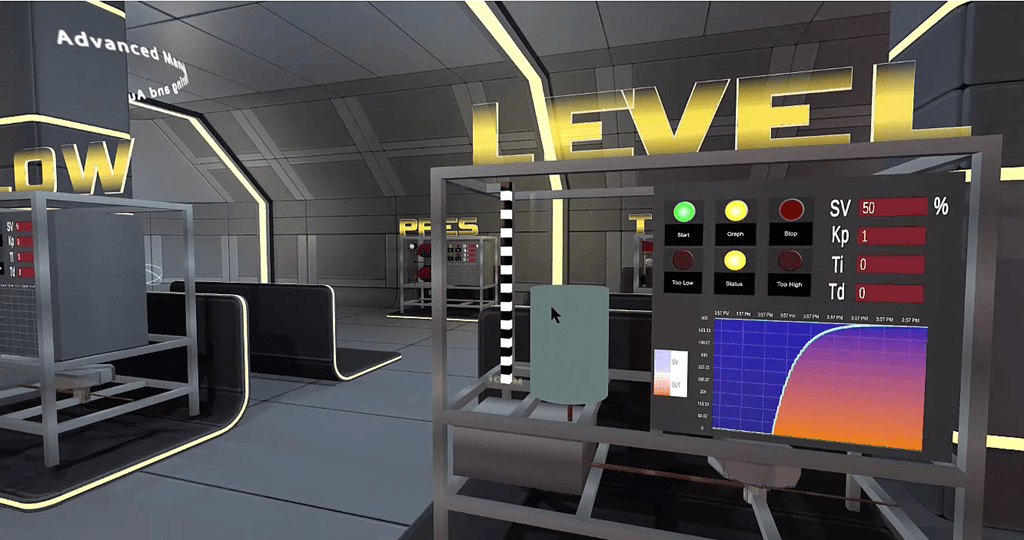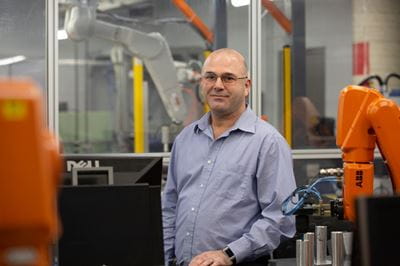
Virtual lab illustrates Sheridan's commitment to meaningful learning experiences during pandemic
As 8,400 learners began their spring/summer semester at Sheridan last week, our faculty continue to develop meaningful and engaging learning experiences that will stretch students’ thinking, build their skills and advance their knowledge — all while being delivered remotely.
One example is the custom-built virtual lab Dr. Andy Alubaidy has created for second-year Electromechanical Engineering Technology advanced diploma students, simulating the hands-on experiences they would enjoy in his Instrumentation and Process Control course. The virtual replication of the C-138 lab at Sheridan’s Davis Campus is being piloted to approximately 80 students during the spring/summer semester, informing Sheridan’s School of Mechanical and Electrical Engineering Technology (MEET)’s plans to virtualize several more labs in time for the fall semester.
“Our commitment to academic quality and integrity remains unwavering in the face of the COVID-19 pandemic,” says Dr. Melanie Spence-Ariemma, Provost and Vice President Academic. “Initiatives like this virtual lab illustrate Sheridan’s support, commitment and continued dedication to inspiring our students throughout their academic journeys.”
With support from MEET Associate Dean Dr. Amjed Majeed, Dr. Alubaidy built his virtual lab using gaming technology — an idea he got after watching his 18-year-old nephew play video games from the popular Resident Evil and Grand Theft Auto franchises. “It’s about appealing to the mindset of our students. During the isolation of COVID-19, their social lives are limited and gaming is one of the few recreational activities they can do,” says Dr. Alubaidy. “So why not use that in education?”

Dr. Alubaidy used two object-oriented programming platforms — Visual Studio and Unity — and the C# (C-sharp) coding he teaches in his class to develop the virtual lab. All actions within the lab can be controlled by a keyboard and mouse, and each of the four trainers in the lab is equipped with Programmable Logic Controllers (PLCs) and Proportional-Integral-Derivative (PID) controllers — allowing students to conduct experiments by inputting values and adjusting tuning knobs. Data from experiments can then be exported into a spreadsheet and used in reports.
“There was already some very good simulation software out there, but none that we felt would inspire the curiosity of the future engineer. Our students need to be inspired, to have the feeling of what happens when you touch the button,” says Dr. Alubaidy, who estimates the virtual labs simulate 95 per cent of what students would experience in person. “I wanted the students to have the same feeling as if they were in our lab — to be able to walk in, see the four trainers there, follow the instructions on their lab sheet and do exactly what they’d do in a real-life project.” Adds Dr. Majeed: “We will be able to ensure all of the learning outcomes are completely met, just like they would have been with traditional course delivery.”
Following completion of the spring/summer semester, Dr. Majeed and Dr. Alubaidy plan to use feedback from students to build more virtual labs for use in at least three more courses in the fall. Dr. Majeed says a virtual component may also be added to Sheridan’s Honours Bachelor of Mechanical Engineering degree program in time for the winter semester — regardless of whether classes have returned to traditional in-person delivery.
“This approach aligns with the world’s movement toward Industry 4.0, which involves virtual automation and digital twins,” says Dr. Majeed. “It may also help us accommodate international students who may not be able to physically come to Canada, providing us with the flexibility to attract a wider target of stakeholders.”
In total, Sheridan faculty retooled, rethought and reorganized nearly 3,000 courses for remote delivery in the final weeks of the winter semester to facilitate remote learning when the COVID-19 pandemic first hit and Sheridan pivoted to alternate delivery. Their efforts were supported by an Online Learning and Teaching Guide developed in partnership by Sheridan’s Centre for Teaching and Learning (CTL) and Library Learning Services.
“Quality and pedagogically-driven curricula should not be measured or constrained by the medium, whether that be traditional face-to-face instruction or online delivery,” says Janet Shuh, Associate Dean of Educational Development and Technology, who was instrumental in pulling together the faculty resource guide. “Rather, they should be driven by other inputs and outcomes such as active engagement, peer and instructor activity, and authentic assessment — all principles showcased in this guide.”
Other highlights of Sheridan’s commitment to maintaining academic integrity, meaningful learning experiences and student support during the pandemic include the launch of “Sheridan Central”, an innovative online campus hub; a Student Guide to Working Remotely that promotes Sheridan’s various technology resources as well as a loaner laptop program; a virtual musical production featuring Honours Bachelor of Music Theatre Performance students; virtual showcasing and celebrations of student achievements; a Pandemic Diaries initiative involving the reflections of eight Journalism students; and an Athletics and Recreation department program that promotes fitness, general wellness and community outreach.
Pictured top right: Screen shot of the custom-built virtual lab created by Sheridan professor Dr. Andy Alubaidy.
Pictured above left: Electromechanical Engineering Technology professor Dr. Andy Alubaidy.
Popular stories
- Sheridan to offer flexible online programs geared to busy working professionals
- Sheridan electrical engineering degree first of its kind in Ontario to be accredited by CEAB
- Sheridan welcomes two Indigenous Engagement and Education Associate Vice Presidents
- Sheridan's new brand reflects its commitment to unlocking opportunities
Media Contact
Meagan Kashty
Manager, Communications and Public Relations


.jpg?rev=53f8afc808914c618910e55ae20aea4f&w=64&hash=A4B760AA1DE2740AB8F8252D28CA3524)

